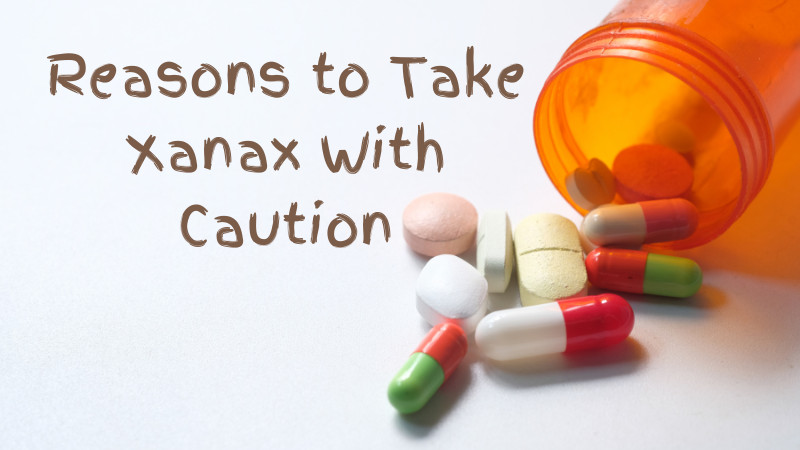In today’s fast-paced world, feelings of anxiety and stress are more common than ever. For many, these feelings can become overwhelming, affecting daily life, relationships, and even physical health.
Enter Xanax, a medication that has been a beacon of relief for countless individuals. But what exactly is Xanax, and why do people take it? This article delves into the reasons behind taking Xanax, its role in treating various anxiety disorders, and other essential aspects to consider.
Whether you’re curious about the reasons to take Xanax or seeking alternatives, we’ll provide a comprehensive guide to help you understand some key considerations worth making with Xanax.
Table of Contents
Generalised Anxiety Disorder: Brief Definition and Symptoms for Adult
Many people feel constant worry, and that’s where medicines like Xanax come in. Let’s dive into one of the common reasons to take Xanax.
Have you ever found yourself constantly worrying about various aspects of your life, even when there’s no apparent reason for concern? If so, you might be familiar with the feelings associated with Generalised Anxiety Disorder (GAD).
GAD is characterised by persistent and excessive worry about various aspects of life, be it money, health, family, work, or other concerns. It’s not just the occasional stress or fear; it’s an overwhelming worry that’s hard to shake off. 1

People with GAD often find themselves anticipating the worst possible outcomes, even when there’s no evidence to support such fears. For instance, they might worry excessively about a loved one’s safety or stress over potential financial troubles, even if they’re financially stable.
What makes GAD particularly challenging is the difficulty in controlling this worry. It’s not just a fleeting thought; it’s a constant presence.
To be diagnosed with GAD, an individual would typically experience uncontrollable worry for more days than not over a span of at least six months. Additionally, they would exhibit three or more specific symptoms, which differentiate GAD from regular, short-term worry related to specific stressors. 2
Generalised Anxiety Disorder Symptoms in Adults
While symptoms of GAD vary from person to person, most adults encounter a mix of emotional, behavioural, and physical signs. These symptoms can change in intensity, often intensifying during stressful periods.
| Emotional Symptoms | Behavioural Symptoms | Physical Symptoms |
| 1. Persistent worries Worry is a main symptom of GAD. People with GAD constantly feel anxious and can’t stop their worrying thoughts. This kind of worry isn’t just about everyday concerns; it’s more intense and can affect daily life. M. Newman, et al., also suggest that understanding this kind of worry can help us learn more about other mental health issues too. 3 | 1. Difficulty relaxing or being alone GAD sufferers may experience adult “autophobia” where they feel a strong and unreasonable fear of being by themselves, even in safe places like their homes. 4 | 2. Feeling that anxiety is beyond control Where you can’t do anything to stop worrying, overthinking and controlling social anxiety disorder. 5 |
| 2. Feeling that the anxiety is beyond control Where you feel that you can’t do anything to stop worrying, overthinking and controlling social anxiety disorder. | 2. Trouble focusing GAD sufferers often have difficulty concentrating. This challenge in focusing is linked to the constant state of worry and anxiety they experience. Research suggests that this difficulty in concentrating can act as a mechanism that further intensifies the symptoms of GAD, making it a significant aspect of the disorder’s pathology. 6 | 2. Sleep disturbances Individuals with GAD frequently experience sleep disturbances due to the condition’s inherent hyperarousal and hypervigilance. As a result, up to 75% of GAD patients also suffer from insomnia. 7 |
| 3. Overwhelming need for certainty about the future People with GAD strongly desire to know exactly what will happen in upcoming events or situations. They typically do not do well with surprises or unpredictability. | 3. Procrastination due to feeling overwhelmed Individuals who experience GAD have a tendency to procrastinate due to heightened feelings of anxiety, stress, or fear of negative outcomes, making it challenging for them to initiate or complete tasks. 8 | 3. Feeling restless or jumpy GAD sufferers often experience poor sleep, which amplifies the sensations of feeling edgy and uneasy. 9 |
| 4. Overwhelming sense of dread People with GAD have an intense feeling of fear, apprehension, or anxiety about something that might happen in the future or an impending situation. It’s more than just a momentary fear; it’s a deep, consuming worry or anticipation of something negative or harmful. | 4. Avoiding anxiety-inducing situations. People stay away from places, events, or interactions that trigger feelings of anxiety or discomfort. | 4. Digestive issues like nausea or diarrhea Individuals with GAD can also face gastrointestinal problems as a symptom of their anxiety. 10 |
Reasons to Take Xanax in Treating Generalised Anxiety Disorder
Xanax, known by its generic name Alprazolam, is one of the most prescribed medications for anxiety. It belongs to the benzodiazepine class of drugs and is primarily used to treat anxiety disorders, including GAD.
The medication works by binding to GABA receptors in the brain, producing anxiolytic (anxiety-reducing) effects. This action helps in alleviating the symptoms of GAD, providing relief from the constant worries and feelings of apprehension or dread that characterise the disorder.

However, while Xanax can be effective, it’s essential to note that it doesn’t cure anxiety but rather reduces the symptoms as a temporary fix. A key factor that presents a concern here is that over time, the body can adapt to the drug, potentially leading to decreased effectiveness. 11 12
Addressing the potential root causes of GAD coming from external stimuli may help with developing tools that provide internalised resilience and help limit your reasons to take Xanax, and form a potential dependency.
Practices such as mindfulness meditation may help GAD sufferers. Working on improving your sleep environment may also be another complementary strategy.
There are many affordable and even free resources to help with GAD instead of simply looking for reasons to take Xanax. Check out these two for starters and empower yourself – if this is your way of doing things.
There’s a very real risk of both physical and psychological dependence where Xanax is concerned, so it’s crucial to only use it in conjunction with therapy and other coping strategies.
We explored 5 side effects of taking Xanax in our Valeria Root vs Xanax comparison as a comprehensive guide when considering medications such as Xanax against natural alternatives.
A Closer Look at Panic Disorders
Panic attack or disorder is diagnosed in individuals who experience spontaneous, seemingly out-of-the-blue panic attacks and are highly preoccupied with the fear of another attack occurring. These panic attacks can happen unexpectedly, even during sleep.

The disorder typically starts in adulthood, after the age of 20. However, children can also be diagnosed with panic disorder, and many exhibit panic-like symptoms.
Approximately 2-3% of Americans face panic disorders in a given year, with women being twice as likely to experience it as men. The disorder can significantly disrupt daily life, leading individuals to miss work, frequently visit doctors, and avoid situations where they fear a panic attack might occur. 13
The impact is even more pronounced when individuals have both agoraphobia and panic disorders. Many individuals are unaware that their condition is genuine and treatable. Some may feel embarrassed or fearful to share their experiences, even with medical professionals or loved ones, and instead, they suffer in silence.
Symptoms in Adults
Panic disorders are characterised by unexpected and repeated episodes of intense fear, often accompanied by physical symptoms. These episodes, known as panic attacks, can happen without warning and can be extremely distressing for the individual experiencing them.
Recognising these symptoms of panic disorder is crucial for timely intervention and management. Let’s take a look at a few:
- Sudden and repeated panic attacks
- Individuals may experience intense episodes of fear that come on quickly and peak within minutes. 14
- Physical symptoms during an attack
- These can include a pounding or racing heart, sweating, chills, trembling or shaking, shortness of breath, chest pain, nausea, stomach cramps, and dizziness. 15
- Fear of another attack
- After experiencing panic attacks, there’s often a persistent concern about having another one.
- Changes in behaviour
- Individuals might avoid places or situations where they’ve had a panic attack before, fearing another occurrence. They also change in maladaptive behaviour such as avoidance of work or school activities. 16
- Overwhelming worry
- People might experience constant worry about the implications of the attack, such as thinking it’s a sign of a heart problem or concerns about losing control.
Reasons to Take Xanax in Treating Panic Attacks
Xanax acts on the GABA A receptor, modulating the GABA-mediated inhibition of neuronal overexcitability.
Researchers considering the role of benzodiazepines in the treatment of panic disorders found that patients with panic disorders might have reduced benzodiazepine binding in various brain regions and possibly lower brain levels of GABA compared to healthy individuals. 17
The anxiolytic effects of benzodiazepines, like Xanax, are thought to be mediated by receptors with the α2 subunit, predominantly found in the limbic area of the brain.
Effects of Xanax
When you consider your reasons for taking Xanax it is important to also consider the potential short-term and long-term implications and the potential side effects.
Short Term
Short-term use of products like Xanax can lead to:
- Drowsiness or fatigue 18
- Dizziness or lightheadedness 19
- Slurred speech 20
- Poor concentration and memory problems 21
- Reduced motor coordination, leading to difficulty in tasks like driving, and 22
- Elevated moods or feelings of euphoria 23
Long Term
While consistent and long-term use of products like Xanax can lead to:
- Physical dependence
- Increased tolerance 24
- Cognitive deficits 25
- Emotional and mood disturbances, and
- Disinhibition 26
Potential Side Effects
Apart from the intended calming effects, Xanax can also cause various side effects, including:
- Digestive issues like nausea or vomiting
- Weight gain or weight loss 27
- Swelling in hands or feet 28
- Difficulty in breathing 29
- Seizures or tremors
- Depression or suicidal thoughts 30
What is Xanax Prescribed Dosage?
This information is provided for illustrative purposes only and is not to be applied as a methodology for self-prescribing. Whatever your reasons for taking Xanax are, due to the nature of Xanax, the administration of this product should only be done under suitably qualified supervision.
The typical starting dose of Xanax for GAD is 0.25 mg to 0.5 mg, taken three times per day. The dose may be adjusted depending on the individual’s response to the medication.
The maximum daily dosage for GAD is reported to be 4 mg, divided into three doses. When decreasing the Xanax dosage, doctors typically use a taper schedule to reduce the risk of withdrawal symptoms. 31
Xanax is available in a tablet form that is taken orally and comes in the following strengths:
- 0.25 milligrams (mg)
- 0.5 mg
- 1 mg
- 2 mg
Usually, your physician will begin with a minimal dose and adjust it gradually until it achieves the desired outcome so that you won’t experience Xanax addiction and abuse.
The goal is to prescribe the least amount that yields the intended effect. The dosage of Xanax is determined by how your body responds to the medication, not by weight.
While the details provided outline standard or recommended dosages, it’s crucial to follow your doctor’s specific prescription. They will identify the optimal dosage tailored to your requirements.
| GAD | The initial recommended dosage of Xanax for panic disorder is 0.5 mg taken three times daily. However, your specific dose might be less than this. Depending on how your body reacts to the medication, your physician might gradually increase your daily dose. Typically, they might raise it by a maximum of 1 mg every 3 to 4 days. While the Xanax guidelines suggest a maximum daily dose of 10 mg, the common dosage is usually less. |
| Panic Disorder Dosage | The initial recommended dosage of Xanax for panic disorder is 0.5 mg taken three times daily. However, your specific dose might be lesser than this. Depending on how your body reacts to the medication, your physician might gradually increase your daily dose. Typically, they might raise it by a maximum of 1 mg every 3 to 4 days. While the Xanax guidelines suggest a maximum daily dose of 10 mg, the common dosage is usually less. |
Should you take Xanax with food?
In the context of the information provided by ARK Behavioral Health, whether you should take Xanax with food depends on your individual circumstances and how your body responds to the medication. Here are the key points to consider:
- Taking Xanax with food can slow down the absorption of alprazolam, potentially reducing its intended effects. 32
- If you frequently experience an upset stomach after taking Xanax, your doctor may suggest taking it with food to alleviate this discomfort.
So, whether you should take Xanax with food or not depends on your specific needs and any side effects you may experience. It’s essential to follow your doctor’s recommendations regarding the timing of your Xanax doses. If you have concerns or experience unusual side effects, it’s best to consult your healthcare provider for personalised guidance on how to take Xanax safely and effectively.
Is Xanax Safe for Elderly People?
No, Xanax (and other benzodiazepines) is not considered safe for long-term use in elderly people for the following reasons:
- Increased Risk of Alzheimer’s Disease
- Chronic benzodiazepine therapy has been linked to an increased risk of Alzheimer’s disease. 33
- Increased Risk of Falls
- Benzodiazepines can cause memory impairment, falls, fractures, and motor vehicle accidents in older adults.
- Risk of Dementia and Death: Even episodic use of benzodiazepines can be harmful. A lifetime use of more than 90 doses, equivalent to twice a week for a year, has been shown to increase the risk of dementia by 50% and double the risk of death. 34 35
- Hospital Admissions: Chronic use can also lead to avoidable emergency department visits, hospital admissions or death. An investigation by the Journal of the American Geriatrics Society found that over 20% of all drug-associated elderly hospital admissions were due to benzodiazepines. 36
- Specific Side Effects for the Elderly: 37
- Severe drowsiness
- Increased chance of physical dependence
- Dizziness and confusion
- Heightened risk of falling
- Unsteadiness and clumsiness
- Kidney, liver, or lung problems
While Xanax and other benzodiazepines might be prescribed for conditions like insomnia or anxiety, their long-term use in elderly individuals is associated with significant risks. It’s essential for patients and healthcare providers to weigh the benefits against the potential dangers and consider alternative treatments when possible.
Valerian Root: A Natural Alternative
Valerian, scientifically known as Valeriana officinalis, is a herb indigenous to Europe and certain regions of Asia. It has been traditionally used as a calming agent for its sedative properties.

Growing up to a height of more than 6 feet, Valerian is notable for its potent aroma. Its effects are believed to be sedative in nature, impacting the brain and the nervous system. Historical records show that Valerian’s medicinal use can be traced back to the ancient civilisations of Greece and Rome. 38
Why Choose Valerian Root Instead of Xanax?
Valerian root is often chosen as an alternative to Xanax for several reasons. Firstly, it is a natural herb that has been used for centuries to treat symptoms of anxiety and insomnia. Many individuals prefer natural remedies over synthetic drugs due to concerns about chemical additives and potential side effects.
Secondly, unlike Xanax, which can lead to dependence and has the potential for misuse, valerian root is non-addictive. This means that individuals can use valerian root without the fear of developing dependence or experiencing withdrawal symptoms. 39
Additionally, valerian root does not have the sedative effects that Xanax has, allowing users to remain alert and functional.
Lastly, combining valerian root with other natural remedies can offer a holistic approach to managing anxiety, providing a broader spectrum of relief. However, it’s essential to consult with a healthcare professional before making any decisions about treatment options.
Curious about natural remedies? Dive into our article on what’s valerian root good for to discover its ancient secrets and modern-day benefits!
FAQs
Why do you need a prescription for Xanax?
You need a prescription for Xanax because it’s a controlled substance with the potential for misuse, dependence, and side effects. A doctor’s oversight ensures its safe and appropriate use.
Can you take Valerian Root and Xanax at the same time?
It’s not recommended to take Valerian Root and Xanax simultaneously without consulting a healthcare professional, as there may be potential interactions.
Does Valerian root help with panic attacks?
Yes, Valerian root is known to have calming effects that may help reduce the severity and frequency of panic attacks.
Is Xanax for sleep or anxiety?
Xanax is primarily prescribed for anxiety, though it can also help with sleep disturbances related to anxiety.
Conclusion
In wrapping up our exploration of the reasons to take Xanax, it’s clear that this medication plays an important role in managing anxiety and related disorders. Its effectiveness in providing relief from alleviating symptoms has made it a go-to for many.
However, as with any medication, it’s crucial to use it with informed awareness and caution. Beyond the pill lies a world of experiences, stories, and insights that can provide a holistic understanding of mental health. We trust in the strength of collective experiences and shared knowledge.
If you’ve found this article enlightening, we invite you to dive deeper into the topic of reasons to take Xanax with us on Instagram and Pinterest, where we discuss, share, and learn from each other’s journeys. Your voice matters, and together, we can navigate the complexities of mental health, one conversation at a time.
References
- “Generalized Anxiety Disorder (GAD)” – ADAA Staff, Last checked 21 September 2023 [Anxiety & Depression Association of America] [Archive] ↩︎
- “Generalized Anxiety Disorder (GAD)” – John Hopkins Medicine Staff, Last checked 21 September 2023 [John Hopkins Medicine] [Archive] ↩︎
- “Worry and Generalized Anxiety Disorder: A Review and Theoretical Synthesis of Evidence on Nature, Etiology, Mechanisms, and Treatment” – M. Newman, S. Llera, T. Erickson, A. Przeworski, L. Castonguay, 18 July 2016 [PubMed Central] [Archive] ↩︎
- “Feeling Anxious When Alone: Science-Backed Strategies That Can Help” – HealthMatch Staff, Last checked 21 September 2023 [HealthMatch] [Archive] ↩︎
- “Generalized Anxiety Disorder (GAD)” – M. Smith, J. Segal, Last checked 21 September 2023 [HelpGuide] [Archive] ↩︎
- “Difficulty Concentrating in Generalized Anxiety Disorder: An Evaluation of Incremental Utility and Relationship to Worry” – L. Hallion, S. Steinman, S. Kusmierski, 4 November 2017 [PubMed Central] [Archive] ↩︎
- “Insomnia in Older Adults with Generalized Anxiety Disorder” – G. Brenes, M. Miller, M. Stanley, J. Williamson, M. Knudson, W. McCall, 1 June 2010 [PubMed Central] [Archive] ↩︎
- “Procrastination, Distress and Life Satisfaction across the Age Range – A German Representative Community Study” – M. Beutel, E. Klein, S. Aufenanger, E. Brahler, M. Dreier, K. Muller, O. Quiring, L. Reinecke, G. Schmutzer, B. Stark, K. Wolfling, 12 February 2016 [PubMed Central] [Archive] ↩︎
- “Overwhelmed by Anxiety?” – L. Hubbard, 16 May 2022 [Mayo Clinic Health System] [Archive] ↩︎
- “What is the link between anxiety and nausea?” – A. Barrell, Last checked 21 September 2023 [Medical News Today] [Archive] ↩︎
- “How is Xanax Prescribed for Social Anxiety Disorder?: When to Take Xanax for This Condition, How It Works, and More” – A. Cuncic, Last checked 21 September 2023 [Verywell Mind] [Archive] ↩︎
- “How Effective is Alprazolam (Xanax) for Anxiety?” – M. Abraham, 10 October 2020 [Calm Clinic] [Archive] ↩︎
- “Panic Disorder” – ADAA Staff, Last checked 21 September 2023 [Anxiety & Depression Association of America] [Archive] ↩︎
- “Panic Disorder: When Fear Overwhelms” – NIMH Staff, Last checked 21 September 2023 [National Institute of Mental Health] [Archive] ↩︎
- “Panic Disorder” – Family Doctor Editorial Staff, Last checked 21 September 2023 [Family Doctor] [Archive] ↩︎
- “Panic Disorder” – C. Cackovic, S. Nazir, R. Marwaha, Last checked 21 September 2023 [National Library of Medicine] [Archive] ↩︎
- “The Role of High-Potency Benzodiazepines in the Treatment of Panic Disorder” – J. Susman, B. Klee, Last checked 21 September 2023 [PubMed Central] [Archive] ↩︎
- “A Review of Alprazolam Use, Misuse, and Withdrawal” – N. Daoud, A. Hamby, S. Sharma, D. Blevins, 12 March 2018 [PubMed Central] [Archive] ↩︎
- “Alprazolam (Oral Route)” – Mayo Clinic Staff, 21 September 2023 [Mayo Clinic] [Archive] ↩︎
- “Xanax Addiction And Abuse” – A. Bhatt, Last checked 21 September 2023 [Addiction Center] [Archive] ↩︎
- “The Effect of Chronic Alprazolam Intake on Memory, Attention, and Psychomotor Performance in Healthy Human Male Volunteers” – Z. Chowdhurry, M. Morshed, M. Shariar M. Bhuiyan, S. Islam, M. Sayeed, 4 July 2016 [PubMed Central] [Archive] ↩︎
- “Effects of Alprazolam on Driving Ability, Memory Functioning and Psychomotor Performance: A Randomized, Placebo-controlled Study” – J. Verster, E. Volkerts, M. Verbaten, 14 February 2002 [Springer Nature] [Archive] ↩︎
- “Do Benzodiazepines Cause a High or Euphoria?” – AAC Editorial Staff, Last checked 21 September 2023 [American Addiction Centers] [Archive] ↩︎
- “Tolerance and Dependence following Chronic Alprazolam Treatment: Quantitative Observation Studies in Female Rhesus Monkeys” – A. Duke, D. Platt, J. Rowlett, 11 January 2020 [PubMed Central] [Archive] ↩︎
- “Does Xanax Cause Memory Loss or Dementia?” – V. Jones, Last checked 21 September 2023[Good Rx] [Archive] ↩︎
- “Comparison of the frequency of behavioral disinhibition on alprazolam, clonazepam, or no benzodiazepine in hospitalized psychiatric patients” – A. Rothschild, J. Rothschild, A. Viguera, M. Murray, S. Brewster, Last checked 21 September 2023 [PubMed Central] [Archive] ↩︎
- “Does Xanax Cause Weight Gain?” – Boca Recovery Center Staff, Last checked 21 September 2023 [Boca Recovery Center] [Archive] ↩︎
- “Alprazolam” – T. George, J. Tripp, Last checked 21 September 2023 [PubMed Central] [Archive] ↩︎
- “Effects of alprazolam on respiratory drive, anxiety, and dyspnea in chronic airflow obstruction: a case study” – J. Greene, F. Pucino, J.Carlson, M. Storsved, G. Strommen, Last checked 21 September 2023 [PubMed Central] [Archive] ↩︎
- “Association between benzodiazepines and suicide risk: a matched case-control study” – V. Cato, F. Hollandare, A. Nordenskjold, T. Sellin, 26 October 2019 [BMC Psychiatry] [Archive] ↩︎
- “Xanax dosage” – C. Eisentein, 18 November 2022 [Medical News Today] [Archive] ↩︎
- “The Effects Of Taking Xanax On An Empty Stomach” – Ark Behavioral Health Editorial Team, 27 July 2023 [ARK Behavioral Health] [Archive] ↩︎
- “Inappropriate benzodiazepine use in elderly patients and its reduction” – C. Tannenbaum, Last checked 21 September 2023 [Journal of Psychiatry and Neuroscience] [Archive] ↩︎
- “Insomnia: Facts, Statistics, and You” – A. Pietrangelo, 18 November 2021 [Healthline] [Archive] ↩︎
- “Insomnia in Older Adults” – V. Nguyen, T. George, G. Brewster, 22 October 2019 [PubMed Central] [Archive] ↩︎
- “Long-Term Continuous Use of Benzodiazepines by Older Adults in Quebec: Prevalence, Incidence and Risk Factors” – M. Egan, Y. Moride, C. Wolfson, J. Monette, 27 April 2015 [Journal of the American Geriatrics Society] [Archive] ↩︎
- “Are The Effects Of Xanax Abuse Worse For The Elderly?” – Bedrock Recovery Center Editorial Team, Last checked 21 September 2023 [Bedrock Recovery Center] [Archive] ↩︎
- “Valerian – Uses, Side Effects, and More” – WebMD Staff, Last checked 21 September 2023 [Web MD] [Archive] ↩︎
- “Valerian” – Mount Sinai Staff, Last checked 21 September 2023 [Mount Sinai] [Archive] ↩︎
Last Updated on 6 months by D&C Editorial Team

